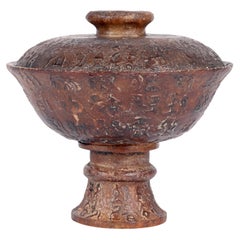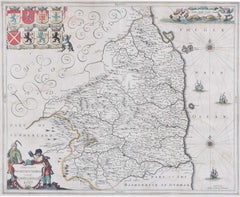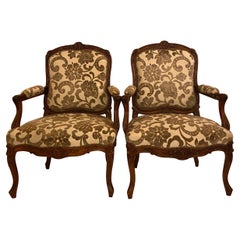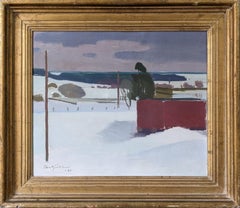England
to
15
116
23
78,801
58,334
33,963
30,630
23,441
18,368
17,311
12,246
7,264
7,121
7,070
5,884
5,354
5,312
4,873
4,840
4,072
3,898
3,836
3,686
3,651
2,736
2,597
2,146
2,034
1,771
1,172
1,100
1,060
1,037
742
714
581
567
564
551
537
513
340
294
272
199
170
151
144
132
98
88
84
63
61
53
53
42
40
30
25
15
13
13
7
6
3
Period: 1640s
Exquisite Pair of 17th Century Capriccios by Viviano Codazzi
Located in London, GB
VIVIANO CODAZZI (c. 1603-1672)
A Pair of Architectural Cappriccios
Oil on Canvas
24 x 28 7/8 inches (60.8 x 73.2 cms)
Provenance: Collection Pérez d...
Category
1640s England
Materials
Oil
Chinese Archaic Style Script Carved Stone Lidded Vessel
Located in Bishop's Stortford, Hertfordshire
An unusual Chinese archaic style script carved lidded stone vessel probably dating from the Qing dynasty or later. The heavily made vessel is made, we believe, from soapstone and com...
Category
1640s Chinese Qing Antique England
Materials
Stoneware
ORIGiNAL 1643 THE TWELVE MONTHS OF THE YEAR AFTER JOACHIM VON SANDART THE ELDER
Located in GB
Royal House Antiques
Royal House Antiques is delighted to offer for sale this super rare and highly collectable suite of twelve original Copper plate engravings dating to 1643 by Ioachimus Sandrart after the original by Joachim Von Sandrart the Elder depicting the months of the year
These are a suite that will never come up for sale again, dating to 1643 they are 381 years old, the copper engraving print outlines clearly visible, each piece signed to the bottom left Ioachimus Sandart Pinxit and to the bottom right what looks like I Suijderhoef jculjit
These are a highly coveted and important suite of mid 17th century prints, they wouldn’t look out of place in the finest library or museums
The condition is perfect, they are mounted with full margins, on museum board with golf leaf slips and hand made 22ct gold leaf side edges
Dimensions each
Height:- 53.5cm
Width:- 43.5cm
Depth:- 2cm
Please note all measurements are taken at the widest point, if you would like any additional or specific measurements please ask
Joachim von Sandrart (12 May 1606 – 14 October 1688) was a German Baroque art-historian and painter, active in Amsterdam during the Dutch Golden Age. He is most significant for his collection of biographies of Dutch and German artists the Teutsche Academie,[1] published between 1675 and 1680.
Sandrart was born in Frankfurt am Main, but the family originated from Mons.[2][3] According to his dictionary of art called the Teutsche Academie, he learned to read and write from the son of Theodor de Bry, Johann Theodoor de Brie and his associate Matthäus Merian, but at age 15 was so eager to learn more of the art of engraving, that he walked from Frankfurt to Prague to become a pupil of Aegidius Sadeler of the Sadeler family. Sadeler in turn urged him to paint, whereupon he travelled to Utrecht in 1625 to become a pupil of Gerrit van Honthorst, and through him he met Rubens when he brought a visit to Honthorst in 1627, to recruit him for collaboration on part of his Marie de' Medici cycle. Honthorst took Sandrart along with him when he travelled to London. There he worked with Honthorst and spent time making copies of Holbein portraits for the portrait gallery of Henry Howard, 22nd Earl of Arundel.
Making all of those copies only served to arouse more curiosity in the young adventurer, and in 1627 Sandrart booked a passage on a ship from London to Venice, where he was welcomed by Jan Lis (whose Bentvueghels bent name was "Pan"), and Nicolas Régnier.[4] He then set out for Bologna, where he was met by his uncle on his mother's side Michael le Blond, a celebrated engraver. With him, he crossed the mountains to Florence, and from there on to Rome, where they met Pieter van Laer (whose bent name was "Bamboccio"). After a few years he undertook a tour of Italy, traveling to Naples, where he drew studies of Mount Vesuvius, believed to be the entrance to the Elysian fields described by Virgil. From there he traveled to Malta and beyond, searching for literary sights to see and paint, and wherever he went he paid his way by selling portraits. Only when he was done traveling did he finally return to Frankfurt, where he married Johanna de Milkau in 1637.
Afraid of political unrest and plague, he moved to Amsterdam with his wife in 1637.
In Amsterdam he worked as a painter of genre works, and portraits. He won a very good following as a painter, winning a lucrative commission for a large commemorative piece for the state visit by Maria of Medici in 1638, which hangs in the Rijksmuseum. This piece was commissioned by the Bicker Company of the Amsterdam schutterij, and shows the members posing around a bust of Maria of Medici, with a poem by Joost van den Vondel hanging below it. The state visit was a big deal for Amsterdam, as it meant the first formal recognition of the Dutch Republic of the seven provinces by France. However, Maria herself was fleeing Richelieu at the time and never returned to France. This piece cemented his reputation as a leading painter, and in 1645 Sandrart decided to cash in and go home when he received an inheritance in Stockau, outside Ingolstadt, he sold his things and moved there. He received 3000 guilders for 2 books of his Italian drawings, that according to Houbraken were resold in his lifetime for 4555 guilders.
Though he rebuilt the old homestead...
Category
1640s European Charles II Antique England
Materials
Paper
PAIR OF ANTIQUE 1640 CAQUETOIRE CARVED WALNUT POLYCHROME PAINTED ARMCHAIRs
Located in GB
Royal House Antiques
Royal House Antiques is delighted to offer for sale this super rare pair of totally original 17th century circa 1640-1680 French Caquetoire armchairs with ornat...
Category
1640s French Charles II Antique England
Materials
Walnut
FOUR ANTIQUE 1640 CAQUETOIRE CARVED WALNUT POLYCHROME PAINTED ARMCHAIRs
Located in GB
Royal House Antiques
Royal House Antiques is delighted to offer for sale this super rare suite of four totally original 17th century circa 1640-1680 French Caquetoire armchairs with...
Category
1640s French Charles II Antique England
Materials
Leather, Walnut
Map of Northumberland by Joannem Janssonium 17th century
Located in London, GB
To see our other original maps, scroll down to "More from this Seller" and below it click on "See all from this Seller" - or send us a message if you cannot find the poster you want....
Category
1640s England
Materials
Engraving
17th Century English Two Panelled Oak Coffer
Located in Skipton, GB
An excellent 17th Century Two Panelled Oak Coffer in good clean original condition, having good colour and patina. The panels are nicely carved with stylized lozenges and the top ra...
Category
1640s English Jacobean Antique England
Materials
Oak
1642 Dated Charles I / Jacobean Hand Carved English Oak Coffer Linen Chest Trunk
Located in GB
We are delighted to offer for sale this sympathetically restored, 1642 Charles I / Jacobean, hand carved English oak coffer, trunk or chest
This piece is stunning, its hand carved t...
Category
1640s British Jacobean Antique England
Materials
Oak
The Wind 1944 Oversize Limited Signature Stamped Edition
By Toni Frissell
Located in London, GB
The Wind
1944
Toni Frissell’s daugther Sidney on the beach as the Wind from A Child’s Garden of Verses, Southampton, Long Island, USA, 194...
Category
1640s Modern England
Materials
Archival Pigment
Mustangs In Flight 1945 Oversize Limited Signature Stamped Edition
By Toni Frissell
Located in London, GB
Mustangs In Flight
1945
Four P-51 Mustangs fly in formation, Ramitelli, Italy 1945
by Toni Frissell
30 x 30" inches / 76 x 76 cm paper size
Archival ...
Category
1640s Modern England
Materials
Archival Pigment
Model In Montego Bay 1946 Oversize Limited Signature Stamped Edition
By Toni Frissell
Located in London, GB
Model In Montego Bay
1946
Fashion model bein rowed across Montego Bay, Jamaica, 1946.
by Toni Frissell
30 x 30" inches / 76 x 76 cm paper size
Archival pigment print
unframed
...
Category
1640s Modern England
Materials
Archival Pigment
18th Century Irish Carved Giltwood Mirror
Located in Shipston-On-Stour, GB
Home / Stock / 18th Century Irish Carved Giltwood Mirror
PrevNext
A good quality George III carved giltwood Irish wall mirror, the scallop crest with foliate swags above a shaped fr...
Category
1640s Irish George II Antique England
Materials
Glass, Giltwood
Bedcover Hanging Curtains Italian Linen Green Ivory Damask Handwoven
Located in BUNGAY, SUFFOLK
Exceptionally rare, Italian, 17th century, green and ivory, damask, linen, woven bedcover
- Made as a luxury item in the mid-17th century, woven with a damask pattern characteristic...
Category
1640s English Baroque Antique England
Materials
Linen
BESLER. A Group of Four Peonies.
Located in London, GB
Four magnificent copper engraved plates with hand-colour from "Hortus Eystettensis", one of the earliest and most famous works in the field.
[Nuremberg and Eichstatt, 1640].
The Hortus Eystettensis is a pictorial record of the flowers grown in the greatest German garden of its time, that of Prince Bishop of Eichstatt, Johann Conrad von Gemmingen.
The garden was begun by Joachim Camerarius in 1596 and, after his death in 1598, completed by Basil Besler...
Category
1640s Naturalistic England
Materials
Copper
1940s 1.87 Carat Diamond and White Gold Cluster Ring
Located in Jesmond, Newcastle Upon Tyne
A stunning vintage 1940s 1.87 carat diamond and 18 karat white gold, platinum set floral cluster ring; part of our diverse diamond jewelry and estate jewelry collections.
This stunning, fine and impressive vintage diamond ring has been crafted in 18k white gold with a platinum setting.
The platinum set floral cluster design is ornamented with a central feature 0.82 Ct transitional modern brilliant round cut diamond, eight claw set in subtle relief.
The feature diamond is surrounded by eight 'petals', each ornamented with a pavé set transitional modern brilliant round cut diamond.
The pierced decorated, elevated and tapering ring shoulders integrate with the main setting and blend seamlessly with the plain ring shank.
The ring is hallmarked to the interior with the marks for 18k gold and platinum (18CT PLAT).
This vintage floral cluster ring...
Category
1640s Unknown Antique England
Materials
Diamond, Platinum, 18k Gold, White Gold
Related Items
Pair of Antique French Carved Walnut Upholstered Armchairs, circa 1860
Located in New Orleans, LA
Pair of Antique French carved walnut sage & Ivory upholstered armchairs, Circa 1860.
These nicely carved armchairs would fit in a traditional or contemporary setting.
Category
Mid-19th Century French Antique England
Materials
Walnut
'Agay, le château et le Sémaphore'. Oil on canvas. Signed.
By Armand Guillaumin
Located in Paris, FR
'Agay, le château et le Sémaphore'.
Oil on canvas. +/- 1922
Signed lower right
Measurements : 60 x 73 cm.
This painting will be recorded in the second volume of the Catalogue Raisonn...
Category
1920s Impressionist England
Materials
Oil
H 23.63 in W 28.75 in
Antique Japanese Enamel Bronze Vase Archaic Vessel Japan, Edo or Meiji Period
Located in Amsterdam, Noord Holland
Marked at base, Japan, 19th century. Provenance: Collection Nieuwenhove.
Condition:
Minimal age signs like some ware to enamel. 1 process flaw or damage to base rim. Size: 330 x ...
Category
Early 20th Century Chinese Meiji England
Materials
Bronze
Oil painting; Italian Landscape in the style of Claude Lorraine (1600-1682).
By Claude Lorrain (circle of)
Located in Uppingham, GB
Large Italian Landscape circa 1890 painted by a heavily influenced follower of Claude Lorraine (1600-1682). Superb depth and detail. Indistinc...
Category
Late 19th Century Realist England
Materials
Oil
Yellow vase with lid, China, Sec. XX
Located in Prato, IT
China, Sec. XX
Decorations on yellow background containing flowers and birds on flowering branches.
Mild spinning on the neck.
Height about 38 cm.
Category
20th Century Chinese England
Materials
Porcelain
Chinese Export Porcelain Snuff or Lidded Bottle hand painted, Qing early 19th C.
Located in Lincoln, Lincolnshire
This is a Chinese porcelain Snuff Bottle or small Lidded Bottle, finely hand painted with flowers, leaves and butterflies and dating to the early 19th century of the Qing Dynasty.
T...
Category
Early 19th Century Chinese Qing Antique England
Materials
Porcelain
H 3.95 in Dm 1.82 in
Large Chinese Late Qing Blue and White Porcelain Vase with Lid
Located in New York, NY
This late Qing, Guangxu-period "windswept" guan jar, copying an earlier Ming style, is ornamented with landscapes (on both the body of the jar and the lid), as well as floral and geo...
Category
Early 1900s Chinese Qing Antique England
Materials
Porcelain
Chinese Qing Dynasty 19th Century Green Glazed Water Vessel with Loop Handles
Located in Yonkers, NY
A Chinese Qing Dynasty antique green glazed water vessel from the 19th century, with petite loop handles. Created in China during the 19th century, this water vessel features a generous circular tapering body adorned with a green glaze and brown accents. Topped with an opening of 5" diameter and comprising of petite loop handles, this Chinese Qing Dynasty 19th century water vessel...
Category
19th Century Chinese Qing Antique England
Materials
Ceramic
Unusual Pair of Antique Victorian Quality Carved Walnut Armchairs
Located in Suffolk, GB
Unusual pair of antique Victorian quality carved walnut armchairs having quality carved walnut spoon backs, beautifully carved walnut open arms standing on shaped carved walnut cabri...
Category
19th Century English Victorian Antique England
Materials
Walnut
Outstanding Victorian Walnut Carved Armchair
Located in Suffolk, GB
Outstanding Victorian carved walnut armchair with outstanding carved detail to the lovely shaped back, beautiful carved shaped arms, carved rounded front rail, standing on lovely car...
Category
19th Century English Antique England
Materials
Walnut
19th Century Chinese Qing Dynasty Imperial Porcelain Lidded Ginger Jar, 1880
Located in Portland, OR
Antique 19th century Chinese Qing Dynasty imperial porcelain lidded ginger jar, circa 1880. The jar of large size and sumptuously decorated with ...
Category
1880s Chinese Qing Antique England
Materials
Porcelain
Early oil depicting the Great Fire of London
Located in London, GB
The Great Fire of London in September 1666 was one of the greatest disasters in the city’s history. The City, with its wooden houses crowded together in narrow streets, was a natural fire risk, and predictions that London would burn down became a shocking reality. The fire began in a bakery in Pudding Lane, an area near the Thames teeming with warehouses and shops full of flammable materials, such as timber, oil, coal, pitch and turpentine. Inevitably the fire spread rapidly from this area into the City. Our painting depicts the impact of the fire on those who were caught in it and creates a very dramatic impression of what the fire was like. Closer inspection reveals a scene of chaos and panic with people running out of the gates. It shows Cripplegate in the north of the City, with St Giles without Cripplegate to its left, in flames (on the site of the present day Barbican). The painting probably represents the fire on the night of Tuesday 4 September, when four-fifths of the City was burning at once, including St Paul's Cathedral. Old St Paul’s can be seen to the right of the canvas, the medieval church with its thick stone walls, was considered a place of safety, but the building was covered in wooden scaffolding as it was in the midst of being restored by the then little known architect, Christopher Wren and caught fire. Our painting seems to depict a specific moment on the Tuesday night when the lead on St Paul’s caught fire and, as the diarist John Evelyn described: ‘the stones of Paul’s flew like grenades, the melting lead running down the streets in a stream and the very pavements glowing with the firey redness, so as no horse, nor man, was able to tread on them.’
Although the loss of life was minimal, some accounts record only sixteen perished, the magnitude of the property loss was shocking – some four hundred and thirty acres, about eighty per cent of the City proper was destroyed, including over thirteen thousand houses, eighty-nine churches, and fifty-two Guild Halls. Thousands were homeless and financially ruined. The Great Fire, and the subsequent fire of 1676, which destroyed over six hundred houses south of the Thames, changed the appearance of London forever. The one constructive outcome of the Great Fire was that the plague, which had devastated the population of London since 1665, diminished greatly, due to the mass death of the plague-carrying rats in the blaze.
The fire was widely reported in eyewitness accounts, newspapers, letters and diaries. Samuel Pepys recorded climbing the steeple of Barking Church from which he viewed the destroyed City: ‘the saddest sight of desolation that I ever saw.’ There was an official enquiry into the causes of the fire, petitions to the King and Lord Mayor to rebuild, new legislation and building Acts. Naturally, the fire became a dramatic and extremely popular subject for painters and engravers. A group of works relatively closely related to the present picture have been traditionally ascribed to Jan Griffier...
Category
17th Century Old Masters England
Materials
Oil, Canvas
Previously Available Items
1940 Mid Century Modernist Swedish Framed Oil Painting, Landscape - Winter Skies
Located in Bristol, GB
WINTER SKIES
Size: 60 x 69 cm (including frame)
Oil on canvas
A tranquil and serene modernist winter scape composition, executed in oil onto canvas and dated 1940.
Depicting a wint...
Category
1640s Modern England
Materials
Canvas, Oil
Ars Moriendi, Dance of Death, Pierre Daret, “Desire only stops at death!”
By Matthäus Merian the Elder
Located in Norwich, GB
L’envie cede a la mort seulement. –
Desire only stops at death. Or: Envy yields to death alone. Death tramples Medusa being pointed to by Hercules who controls a multi-headed dragon / monster.
Engraving on hand laid (verge) paper.
From: ‘La Doctrine des Moeurs ..’ printed by Louys Sevestre for Pierre Daret, Paris, 1646. First edition. Author: Marin le Roy de Gomberville. Made by order of Mazarin for the instruction of the young Louis XIV. The plates are copies in reverse after Otto van Veen...
Category
1640s Dutch Baroque Antique England
Materials
Paper
H 12.13 in W 8.51 in D 0.08 in
Charles I Band Sampler, 1649, by HW Aged 8
Located in Chelmsford, Essex
1649 band sampler by HW aged 8, worked in silks on linen ground, in a variety of fine stitches including raised work and Algerian eye. Simple line borders...
Category
1640s British Folk Art Antique England
Materials
Silk
Ballet Dancers - Impressionist Oil, Figures in Interior by Jules Rene Herve
By Jules René Hervé
Located in Marlow, Buckinghamshire
A beautiful oil on board by popular French impressionist painter Jules Rene Herve depicting ballerinas in white tutus standing in a grand interior.
Signature:
Signed lower right an...
Category
1640s Impressionist England
Materials
Oil, Board
The Archangel Michael Defeating Satan
Located in London, GB
FLEMISH circa 1640
The Archangel Michael Defeating Satan
oil on copper
18 x 16.5 inches, inc. frame
The archangel appears wearing classical armour ...
Category
1640s Baroque England
Materials
Oil
17th Century Spanish Side or Serving Table
Located in Martlesham, GB
Mid-17th century Spanish chestnut side or serving table with three chip carved drawers, standing on chamfered legs united by stretchers, the drawers looking to have the original iron...
Category
1640s Spanish Antique England
Materials
Chestnut








